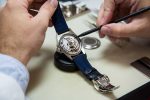Reviews
Beyond Basics — The Heritage Black Bay
That was the easy part, knowing the three most important things about the Tudor MT56 group of automatic calibres. They’re made in house, they’re COSC certified, they’re forward thinking. You see, easy. Now comes the part that takes a bit more effort — understanding what makes these three things so important. It’ll take 10 minutes and I promise to make it as painless as possible. Let’s get started, shall we?
Manufacturing Myths
For various reasons that are too complicated (and fraught) to get into, the word “manufacture”, and by extension, “in house”, has become synonymous with quality watchmaking. People see the “in house” label and in their minds it automatically translates to a bunch of arbitrary bonus points that elevate the watch in question far above an equivalent model with an externally sourced movement. This is just such bad logic that I regularly get quite frustrated with it, because it devalues the legitimate work that some companies put into becoming a true watch manufacture with strong, qualitative products.
When Tudor introduced the calibre MT5621 in 2015, installed within the North Flag, it became a true movement manufacturer. The design of the MT5621 was led by Tudor, it was made only for Tudor and by Tudor, it was constructed according to the values of Tudor — in terms of ownership, creation and production, this movement was what allowed the company to preface its movement reference numbers with the letters M and T. Those letters stand for Mouvement Tudor.
Tudor was founded in 1946. The oldest watch companies around today were founded in the early to mid-18th century, so they’re over 200 years old. As mentioned earlier, Tudor is 70 this year. If you use the proportions of a human lifespan as an analogy to describe the growth and development of a watch company, Tudor is more or less in the prime of life right now, and it’s time that Tudor had its own movements.
The MT56 calibres did right by the brand.
The Tudor North Flag was Tudor’s first fully certified chronometer. This is a huge deal. Usually if a company uses externally sourced components for most of its life and then starts to make its own, it stands to reason that the new stuff isn’t likely to work as well as the tried and tested parts. Not at first, in any case. (This, by the way, is why the uncritical fixation with manufacture status is such a bad idea.) By arming its first in-house movement with COSC certification, Tudor have neatly avoided this pitfall and made a resounding statement of strength as a result — their move towards in-house manufacturing is not a status thing, but is based solely on being able to improve the quality of their watches.
For a while now, the technical side of Tudor watches took a back seat while the design and lifestyle aspects garnered headlines and drew the spotlights. There’s a big difference between a watch company and a watchmaking company, and Tudor totally levelled up with the MT5621. The criteria of the COSC certification ensures that the fundamental raison d’être of mechanical horology — to keep time with the greatest possible accuracy — is preserved.
The MT56 calibres did right by watchmaking.
The unusually clear-eyed approach of Tudor in creating its in-house calibres is seen in every feature of its movement construction. Tudor watches are built to serve the needs and desires of their wearers, and the company’s in-house movements were designed from the ground up to address these needs and desires.
The 70-hour power reserve, combined with an automatic winding system, is an enormous convenience for the customer who might choose to go up to three days between putting the watch down and strapping it on again. The previous movements used by Tudor had just over 40 hours of power reserve, which led to more instances of having to wind and set the watch before wearing it.
The lightweight, corrosion-resistant and a magnetic silicon hairspring is held in position by a traverse balance bridge (anchored at both ends for stability as compared to the more aesthetic balance cock, which is only fixed at one end). Probably not everyone who wears a Tudor watch has the kind of active lifestyle that would take full advantage of the robust movement construction — I will readily admit to a highly sedentary existence despite occasionally feeling twinges of guilt about not giving my Heritage Black Bay the adventurous life it was designed for — but that doesn’t blunt the ambition of the MT56 calibres in the slightest.
If a watch is truly built to be a part of your life, it should be able to keep up with whatever you choose to do and wherever you choose to go. This is something that Tudor have meticulously translated into their movements.
The MT56 calibres did right by customers.
So there you have it — a complete breakdown of why and how the MT56 group of in-house automatic movements by Tudor should factor in the mind of anyone considering a watch purchase. By no means is this everything there is to know about Tudor movements, but it is everything you need to know.



















